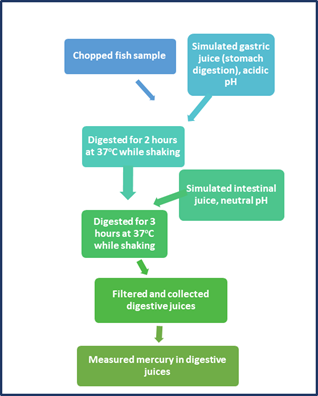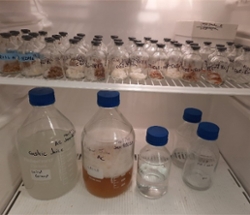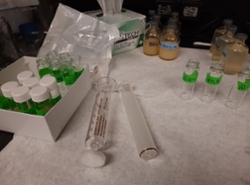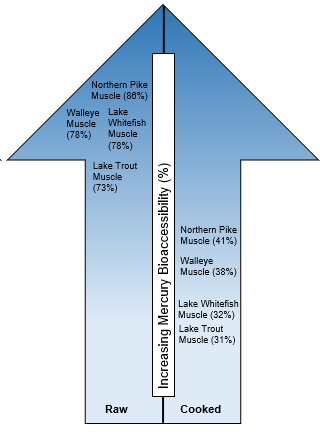Raw or cooked? Mercury concentrations and bioaccessibility in northern freshwater fish
By:
- Sara Packull-McCormick, School of Public Health Sciences, University of Waterloo
- Alicia Cowan, School of Public Health Sciences, University of Waterloo
- Heidi Swanson, Department of Biology, University of Waterloo
- Brian Laird, School of Public Health Sciences, University of Waterloo (Corresponding Author)
Indigenous communities in northern Canada rely on locally harvested traditional foods, including fish, which provides them with nutritional, cultural, and social benefits. However, fish can contain environmental contaminants such as mercury. This may pose a health risk for those who consume large amounts of fish with elevated mercury concentrations. Monitoring projects have detected elevated mercury concentrations in some fish species from some lakes in northern Canada. However, the bioaccessiblity of mercury in the tissue of these northern Canadian freshwater fish is not yet known.
Definition of bioaccessibility: Bioaccessibility is the amount of a chemical that is released from food (that was eaten) into the gastrointestinal juices during digestion. This is the amount of a chemical from food that could potentially be absorbed into the body.
Researchers at the University of Waterloo have been investigating the bioaccessibility of mercury in freshwater fish samples. The bioaccessibility of mercury seems to be different between the types of fish and lakes examined. This research is part of the Northern Water Futures project, funded by Global Water Futures (GWF) and the National Science and Engineering Research Council (NSERC). Work under this project is conducted in collaboration with northern Indigenous communities and examines the balance between contaminant risks and nutritional benefits from the consumption of wild-harvested traditional foods.
Using a Model of Human Digestion

Bioaccessibility refers to the amount of a chemical (in this case mercury) that is released into the gastrointestinal juices during digestion. It is important to study, as not all of the mercury in a food item, such as fish, may be absorbed into the body. Bioaccessiblity testing can give us a conservative estimate of the amount of mercury from a food item that can be absorbed. Mercury bioaccessibility can be measured in the lab through the use of a human digestion model (see flowchart).
Measuring Mercury Bioaccessibility in Northern Freshwater Fish
The bioaccessibility of mercury in northern freshwater fish species is unknown so to address this, we worked with samples of Lake Whitefish, Northern Pike, Walleye, and Lake Trout caught from lakes in the Northwest Territories (NWT), Canada. Most of our analysis was done on raw samples of fish muscle, but for some of the larger samples, we tested a portion of cooked fish (pan fried) as well.



Images of fish samples being cooked (pan fried in water)
Mercury concentrations were measured in the raw and cooked samples and then a portion of each sample was digested in the gastrointestinal model to simulate human digestion. After the digestion and after the fluids were filtered to remove any undigested pieces, mercury concentrations were measured in the digestive juices to determine the bioaccessible concentrations of mercury. These concentrations were compared to the concentrations measured in the fish before digestion to determine what percent of the mercury was bioaccessible.


Images of the lab-based method to simulate human digestion to measure mercury bioaccessibility
Results - Mercury Bioaccessibility in Northern Freshwater Fish

In the raw samples, total mercury concentrations were lowest in Lake Whitefish and highest in Walleye and Northern Pike. This was expected as Walleye and Northern Pike are higher in the food chain and prey on other fish while Lake Whitefish is lower on the food chain.
Mercury bioaccessibility ranged on average between 73% to 86% for the four types of raw fish examined. This fits within the range of mercury bioaccessibility reported from other studies. However, the other studies mainly focused on marine/ocean fish and show that mercury bioaccessibility can vary widely between fish species.
Mercury concentrations and bioaccessibility were also measured in cooked samples. Mercury concentrations were higher in the cooked compared to raw fish. This was likely because of moisture loss (as steam) during the cooking process. However, the mercury bioaccessibility was much lower for the cooked samples and ranged between 31% to 41% for the types of fish examined. Even though the mercury concentrations were higher after cooking, because the percent bioaccessibility was so much lower, overall, the bioaccessible mercury was lower in the cooked compared to raw samples. This is similar to other studies on marine fish that found that cooking resulted in increased mercury concentrations but decreased mercury bioaccessibility.
Future Directions
This research helps us in our goal to better understand the exposure of northern populations to mercury from their consumption of fish. This study provides an important dataset to fill the gap relating to total mercury bioaccessibility in northern freshwater fish species. However, mercury bioaccessibility is only one of several factors that can impact a population’s exposure to mercury. As a next step, statistical models are being created to estimate the mercury exposure of study participants in several communities in the Northwest Territories. We will include the mercury bioaccessibility data in the models to see if it improves the exposure estimates. These models will help us understand the implications of mercury bioaccessibility data for the health of the northern communities we work with. Additionally, future work should look at the mercury bioaccessibility of other commonly eaten northern freshwater fish species. It should also look at the effects of other commonly used traditional cooking/preparation methods as this study was only able to look at one method (pan frying).
Acknowledgements
We would like to give many thanks to our community partners, northern partners, and research partners that made this research possible.
We acknowledge the support of the Natural Sciences and Engineering Research Council of Canada (NSERC). Cette recherche a été financée par le Conseil de recherches en sciences naturelles et en génie du Canada (CRSNG).
This project was also supported by Global Water Futures/Northern Water Futures, the Northern Contaminants Program, and the University of Waterloo. Thank you to all the other organizations and individuals who made this project possible.
